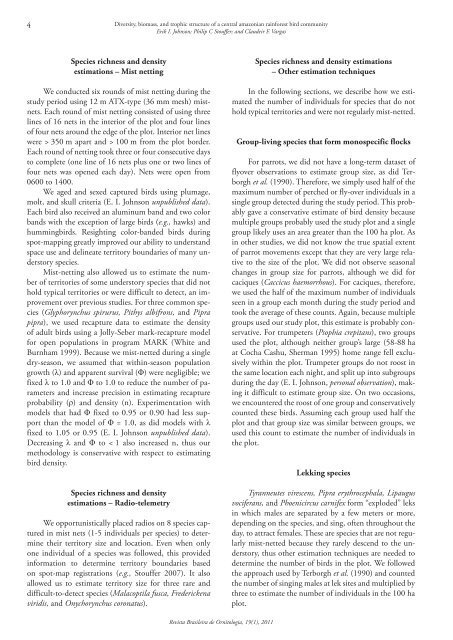Capa 19(1) - fechada.indd - Sociedade Brasileira de Ornitologia
Capa 19(1) - fechada.indd - Sociedade Brasileira de Ornitologia
Capa 19(1) - fechada.indd - Sociedade Brasileira de Ornitologia
Create successful ePaper yourself
Turn your PDF publications into a flip-book with our unique Google optimized e-Paper software.
4 Diversity, biomass, and trophic structure of a central amazonian rainforest bird community<br />
Erik I. Johnson; Philip C Stouffer; and Clau<strong>de</strong>ir F. Vargas<br />
Species richness and <strong>de</strong>nsity<br />
estimations – Mist netting<br />
We conducted six rounds of mist netting during the<br />
study period using 12 m ATX-type (36 mm mesh) mistnets.<br />
Each round of mist netting consisted of using three<br />
lines of 16 nets in the interior of the plot and four lines<br />
of four nets around the edge of the plot. Interior net lines<br />
were > 350 m apart and > 100 m from the plot bor<strong>de</strong>r.<br />
Each round of netting took three or four consecutive days<br />
to complete (one line of 16 nets plus one or two lines of<br />
four nets was opened each day). Nets were open from<br />
0600 to 1400.<br />
We aged and sexed captured birds using plumage,<br />
molt, and skull criteria (E. I. Johnson unpublished data).<br />
Each bird also received an aluminum band and two color<br />
bands with the exception of large birds (e.g., hawks) and<br />
hummingbirds. Resighting color-ban<strong>de</strong>d birds during<br />
spot-mapping greatly improved our ability to un<strong>de</strong>rstand<br />
space use and <strong>de</strong>lineate territory boundaries of many un<strong>de</strong>rstory<br />
species.<br />
Mist-netting also allowed us to estimate the number<br />
of territories of some un<strong>de</strong>rstory species that did not<br />
hold typical territories or were difficult to <strong>de</strong>tect, an improvement<br />
over previous studies. For three common species<br />
(Glyphorynchus spirurus, Pithys albifrons, and Pipra<br />
pipra), we used recapture data to estimate the <strong>de</strong>nsity<br />
of adult birds using a Jolly-Seber mark-recapture mo<strong>de</strong>l<br />
for open populations in program MARK (White and<br />
Burnham <strong>19</strong>99). Because we mist-netted during a single<br />
dry-season, we assumed that within-season population<br />
growth (λ) and apparent survival (Φ) were negligible; we<br />
fixed λ to 1.0 and Φ to 1.0 to reduce the number of parameters<br />
and increase precision in estimating recapture<br />
probability (ρ) and <strong>de</strong>nsity (n). Experimentation with<br />
mo<strong>de</strong>ls that had Φ fixed to 0.95 or 0.90 had less support<br />
than the mo<strong>de</strong>l of Φ = 1.0, as did mo<strong>de</strong>ls with λ<br />
fixed to 1.05 or 0.95 (E. I. Johnson unpublished data).<br />
Decreasing λ and Φ to < 1 also increased n, thus our<br />
methodology is conservative with respect to estimating<br />
bird <strong>de</strong>nsity.<br />
Species richness and <strong>de</strong>nsity<br />
estimations – Radio-telemetry<br />
We opportunistically placed radios on 8 species captured<br />
in mist nets (1‐5 individuals per species) to <strong>de</strong>termine<br />
their territory size and location. Even when only<br />
one individual of a species was followed, this provi<strong>de</strong>d<br />
information to <strong>de</strong>termine territory boundaries based<br />
on spot-map registrations (e.g., Stouffer 2007). It also<br />
allowed us to estimate territory size for three rare and<br />
difficult-to-<strong>de</strong>tect species (Malacoptila fusca, Fre<strong>de</strong>rickena<br />
viridis, and Onychorynchus coronatus).<br />
Species richness and <strong>de</strong>nsity estimations<br />
– Other estimation techniques<br />
In the following sections, we <strong>de</strong>scribe how we estimated<br />
the number of individuals for species that do not<br />
hold typical territories and were not regularly mist-netted.<br />
Group-living species that form monospecific flocks<br />
For parrots, we did not have a long-term dataset of<br />
flyover observations to estimate group size, as did Terborgh<br />
et al. (<strong>19</strong>90). Therefore, we simply used half of the<br />
maximum number of perched or fly-over individuals in a<br />
single group <strong>de</strong>tected during the study period. This probably<br />
gave a conservative estimate of bird <strong>de</strong>nsity because<br />
multiple groups probably used the study plot and a single<br />
group likely uses an area greater than the 100 ha plot. As<br />
in other studies, we did not know the true spatial extent<br />
of parrot movements except that they are very large relative<br />
to the size of the plot. We did not observe seasonal<br />
changes in group size for parrots, although we did for<br />
caciques (Caccicus haemorrhous). For caciques, therefore,<br />
we used the half of the maximum number of individuals<br />
seen in a group each month during the study period and<br />
took the average of these counts. Again, because multiple<br />
groups used our study plot, this estimate is probably conservative.<br />
For trumpeters (Psophia crepitans), two groups<br />
used the plot, although neither group’s large (58‐88 ha<br />
at Cocha Cashu, Sherman <strong>19</strong>95) home range fell exclusively<br />
within the plot. Trumpeter groups do not roost in<br />
the same location each night, and split up into subgroups<br />
during the day (E. I. Johnson, personal observation), making<br />
it difficult to estimate group size. On two occasions,<br />
we encountered the roost of one group and conservatively<br />
counted these birds. Assuming each group used half the<br />
plot and that group size was similar between groups, we<br />
used this count to estimate the number of individuals in<br />
the plot.<br />
Lekking species<br />
Tyranneutes virescens, Pipra erythrocephala, Lipaugus<br />
vociferans, and Phoenicircus carnifex form “explo<strong>de</strong>d” leks<br />
in which males are separated by a few meters or more,<br />
<strong>de</strong>pending on the species, and sing, often throughout the<br />
day, to attract females. These are species that are not regularly<br />
mist-netted because they rarely <strong>de</strong>scend to the un<strong>de</strong>rstory,<br />
thus other estimation techniques are nee<strong>de</strong>d to<br />
<strong>de</strong>termine the number of birds in the plot. We followed<br />
the approach used by Terborgh et al. (<strong>19</strong>90) and counted<br />
the number of singing males at lek sites and multiplied by<br />
three to estimate the number of individuals in the 100 ha<br />
plot.<br />
Revista <strong>Brasileira</strong> <strong>de</strong> <strong>Ornitologia</strong>, <strong>19</strong>(1), 2011

















